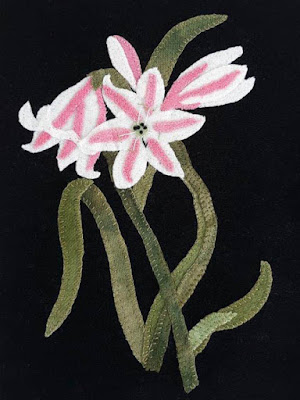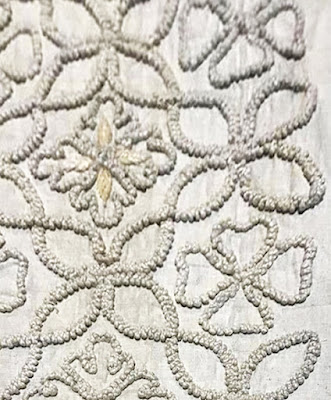Flora Delanica #7: Summer Lily or Asphodel Lily by
Nancy Phillips in wool.
The skirt was cut into pieces for descendants,
one of whom Ruth Hayden was lucky enough to
inherit a piece, inspiring her to write about Mary.
The late-life paper collages may be an aging woman's response to her fading eye/hand skills, so impressive in her middle years. Biographer Clarissa Campbell Orr writes that Mary and her friends were embroidering show aprons in 1740 when Mary was about 40.
Summer Lily or Asphodel Lily by Becky Brown
In her 1915 book Quilts: Their Story & How to Make Them, Marie D. Webster, tells of two Delany quilts: One "Of white linen worked in flowers, the size of nature, delineated with the finest coloured silks in running stitch," the other "Upon a foundation of nankeen [a naturally yellow cotton]. This was unique in that no colours were used besides the dull yellow of the background. Applied designs of leaves tied together with ribbons, all cut from white linen and stitched to the nankeen with white thread."

Augusta Waddington Hall, Lady Llanover (1802-1896)
in traditional Welsh costume
The second quilt seems to have featured white cotton appliqued leaves stitched to the minimally contrasting yellow background. Webster interpreted this as what we'd call an applique quilt. Lady Llanover also described it as "an intricate pattern of leaves cut out in white linen and sewed down with white knotting on bright dark blue linen;" which makes a little more sense, but blue or nankeen colored---no more information is in the literature.
White Work Bedcover
About 96 inches square
The Ulster Museum in Belfast owns a third quilt or bedcover attributed to Mary Delany---all whitework. Catalog notes:
"Irish linen coverlet worked with knotted and couched cords. It has an overall trellis design with a central medallion, by Mrs Mary Delany."
Inked on the piece: “This quilt was worked by Mrs Delany
& presented by her to Thos. Sandford on the day of his birth 1765.”
We might call this kind of embroidery a candlewick spread or a chenille bedspread.
Is the piece finished?
Did Mary actually do the knotting or just draft the complex design? There are several references to Mary working on a quilt. One day at Delville in 1750 while Patrick Delany and a friend were out:
"Miss Ford ... read to me whilst I worked at my quilt till the gentlemen came home to dinner."
Marguerite, Madame Crozat, 1741
by Jacque Andre-Joseph Aved, Musee Fabre
This is how ladies spent their time, someone reading aloud while friends did plain sewing or fancy needlework.
The Block
#7 Summer, Crimson or Asphodel Lily
(Crinum Zeylanicum) Asphodel Lily by Mary Delany
Collection of the British Museum
Applique on the diagonal to an square cut 10-1/2" or on the vertical center of a rectangle cut 9-1/2" x 12-1/2".

One Way to Print the Pattern:
Create a word file or a new empty JPG file that is 8-1/2" x 11".
Click on the image above.
Right click on it and save it to your file.
Print that file out 8-1/2" x 11". Note the inch square block for reference.
Adjust the printed page size if necessary.
Summer Lily or Asphodel Lily by Barbara Brackman
A Little More Mary
Delany
Convallaria Majalis
Lilies of the Valley were a life-long theme.
Further Reading & Shopping
https://thegardenstrust.blog/2018/07/07/mrs-delanys-petticoat/
https://yalebooks.yale.edu/book/9780300142792/mrs-delany-and-her-circle
See the Ulster Museum's needlework collection here:
https://www.nmni.com/collections/history/textiles-and-costume
I didn't see a photo of Mary's knotted bedcover there but found the pictures above on their Facebook page.
A possible fourth bedcover described by Lady Llanover:
"Another most wonderful quilt worked by Mrs. Delany, and one of the very few things she never finished. It appears only to have been done when she had no painting to occupy her, and when old age at last forbad the execution of pictures (either with pencil or scissors) this quilt could not be completed. It is on white linen, worked in flowers, the size of nature, delineated with the finest coloured silks in running stitch, which is made use of in the same manner as by a pen etching on white paper; the outline was first drawn with pencil, each flower is different and evidently done at the moment from the original."
















No comments:
Post a Comment